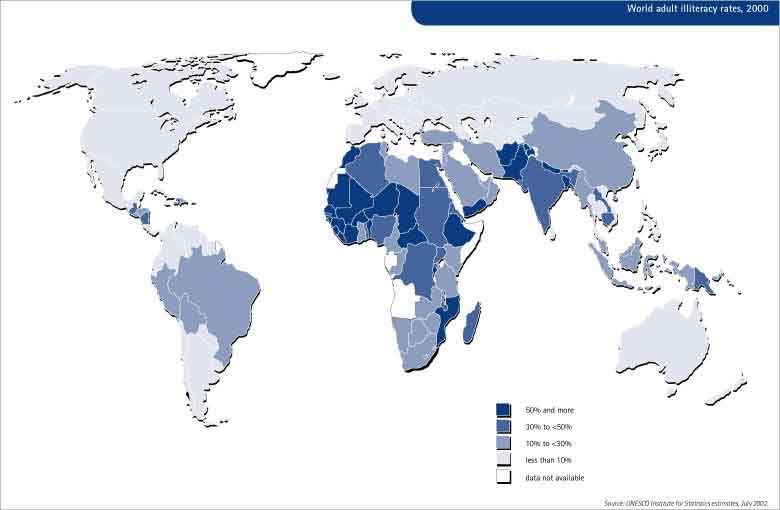|
|
| Home | Software | Web Games | Quizzes | Free for Teachers | Patents | E-mail Us | Links |
|
|
World Illiteracy
Literacy is the ability to read and write. In modern context, the word means reading and writing in a level adequate for written communication and generally a level that enables one to successfully function at certain levels of a society.
The standards for what level constitutes "literacy" vary between societies. Other skills such as computer skills or basic numeracy may also be included, as there are many people who cannot read letters but can read numbers, and even learn to use a computer (in a limited way) while remaining unable to read text. These and the increasing inclusion of sound, still and moving images and graphical elements in digitally based communication call for an even broader concept of literacy. Recently the National Council of Teachers of English have added "visually representing" to the list of communicative competences that are considered to constitute literacy.
Many policy analysts consider literacy rates a crucial measure of a region's human capital. This claim is made on the grounds that literate people can be trained less expensively than illiterate people. Policy makers also argue that literacy increases job opportunities and access to higher education. In Kerala, India, for example, female and child mortality rates childrates declined dramatically in the 1960s, when girls schooled to literacy in the education reforms after 1948 began to raise families. Recent researchers, however, argue that correlations such as the one listed above may have more to do with the effects of schooling rather than literacy in general.

Map of world literacy rates by country. Source: UNESCO Institute for Statistics
Illiteracy is most prevalent in developing countries. South Asian, Arab and Sub-Saharan African countries are regions with the highest illiteracy rates at about 40 to 50%. East Asia and Latin America have illiteracy rates in the 10 to 15% region while developed countries have illiteracy rates of a few percent.
Within ethnically homogenous regions, literacy rates can vary widely from country or region to region. This often coincides with the region's wealth or urbanization, though many factors play a role.
Many have been concerned about the lack of literacy in the world population, despite the fact that literacy rates have increased steadily over the past few decades, especially in the third world. Third world nations which adopted communism (China, Cuba, and Vietnam, for example), experienced some of the most dramatic growth of literacy, approaching US and European rates. The United Nations defines illiteracy as the inability to read and write a simple sentence in any language. Figures of 1998 show that 16% of the world population is illiterate (by the UN definition).
In the United States alone, one in seven persons (i.e., over 40 million people) can barely read a job offer or utility bill, which arguably makes them functionally illiterate in a developed country such as the US. In 2003 the National Assessment of Adult Literacy (NAAL), conducted by the US Department of Education, found that fourteen percent of American adults scored at this “below basic” level in prose literacy. More than half of these persons did not have a high-school diploma or GED. Thirty-nine percent of persons at this level were Hispanic; twenty percent were Black; and thirty-seven percent were White. In comparison with the previous NAAL study in 1992, overall literacy had declined by 2003, with men doing more poorly than women (and with a widening gap between the sexes), Blacks improving (slightly less than one in four at the “below basic” level in 2003), and Hispanics substantially declining in literacy (nearly half of Hispanics in the US were at the “below basic” level in 2003). Literacy among college graduates declined between 1992 and 2003, with less than one third of all graduates at the highest “proficient” level in 2003, and less than half of all graduates with advanced degrees at this level.
Seven million UK residents are functionally illiterate according to Government figures. Another problem in the developed countries is the rise of secondary and tertiary illiteracy in recent years, i.e. the complete or partial loss of previously existing reading and writing skills due to lack of practice.
Among the Arab states, more than 25% of men and 50% of women were not literate as of 2000. The most likely reason for low levels of literacy is lack of education.
Many people in the third world cannot see the point of learning to read, as they are able to function perfectly well without doing so.
Some have suggested that the lower the illiteracy rate of a country, generally the longer the life span, although critics have argued that this is a Post hoc fallacy. Literacy does aid the provision of healthcare in a number of very practical ways (ability to read prescriptions and understand doctors' conclusions are two examples of this).
All text is available under the terms of the GNU Free Documentation License.